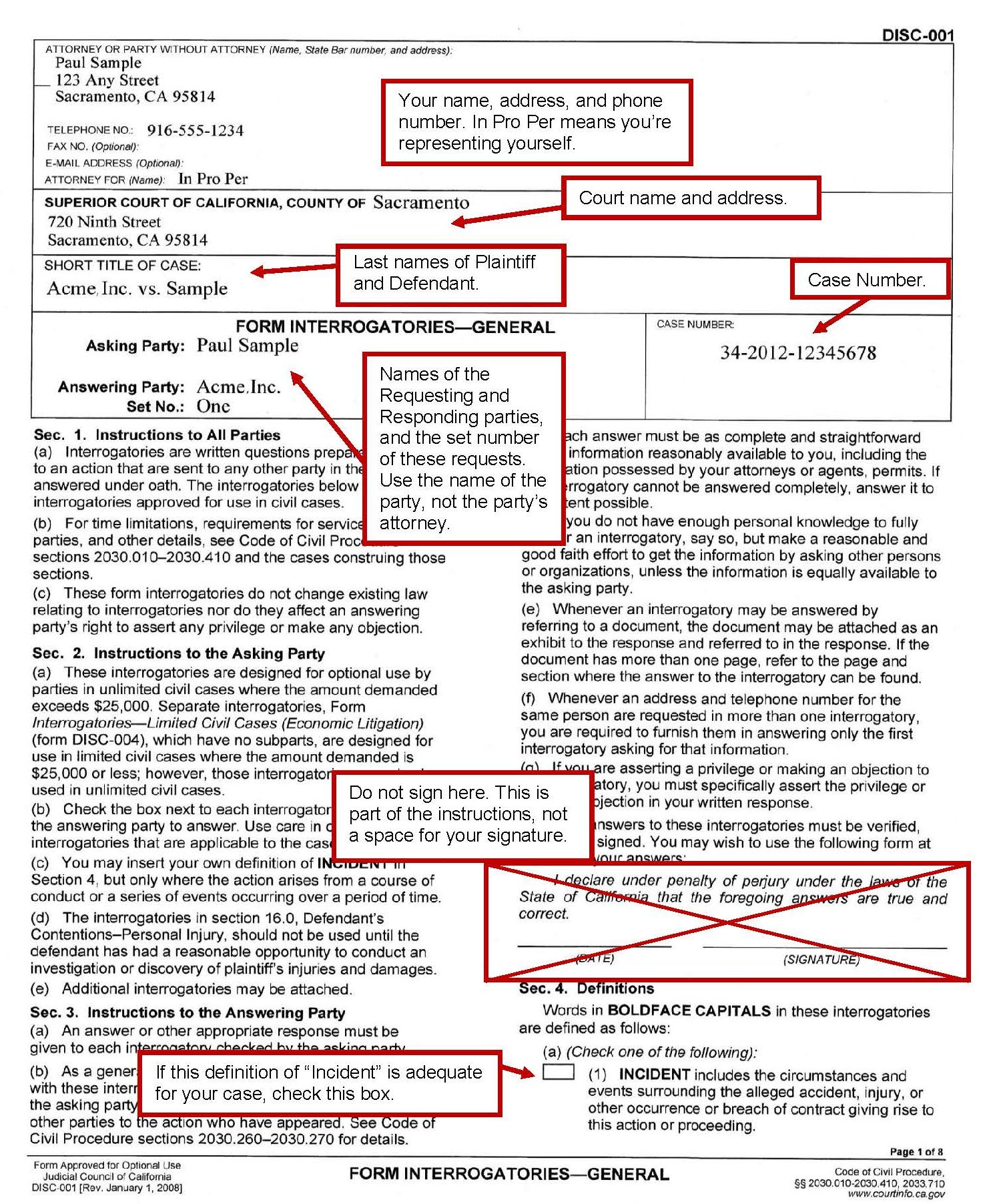Discovery: Form Interrogatories
Interrogatories are written questions sent by one party to another, which the responding party must answer under penalty of perjury. Interrogatories allow the parties to ask who, what, when, where and why questions, making them a good method for obtaining new information in a case.
There are two types of interrogatories: form interrogatories and special interrogatories. This Guide will discuss form interrogatories; for more information on special interrogatories, see the Step-by-Step guide on Special Interrogatories.
Templates and Forms
- Form Interrogatories – General (DISC-001)
- Form Interrogatories – Employment Law (DISC-002)
- Form Interrogatories – Unlawful Detainer (DISC-003)
- Form Interrogatories – Construction Litigation (DISC-005)
Form interrogatories are an easy way for parties to ask common questions by simply checking the boxes for the questions they wish to ask. In a limited civil case (cases less than $25,000, or $35,000 if filed after Jan. 1, 2024) you may ask each party only 35 questions total, whether they are form interrogatories, special interrogatories, requests for admission, or requests for production of documents. Keep this limit in mind when writing your requests, to ensure that you are able to obtain all the information you’ll need for your case. If you ask the other party to answer 35 interrogatories, you will not be able to request any admissions or request any documents.
Step-by-Step Instructions
1
Select the Proper Form(s)
Form interrogatories have been created for use in both limited and unlimited cases.
Subparts are prohibited in interrogatories in limited cases, to ensure that only 35 questions total are asked. For this reason, a form was created specifically for limited civil cases. If you have a limited case, you must use this form:
In an Unlimited Civil Case (over $25,000, or $35,000 if filed after Jan. 1, 2024), parties may ask an unlimited number of form interrogatories. These questions may include subparts as appropriate. Several forms have been created for the most common questions in a variety of case types:
- Form Interrogatories – General (DISC-001)
- Form Interrogatories – Employment Law (DISC-002)
- Form Interrogatories – Unlawful Detainer (DISC-003)
- Form Interrogatories – Construction Litigation (DISC-005)
You may use any of these forms to ask interrogatories in an unlimited case. Most of the questions included in form interrogatories are fairly easy to understand, if you read them carefully.
2
Complete the Form(s)
In this Guide, we will explain the questions included in the general forms (Form Interrogatories – General (DISC-001) and Form Interrogatories – Limited Civil Cases (DISC-004)), which mirror each other. Instructions for completing the top caption of the form are contained in the sample pages included at the end of this Guide.
Check the box for each question you wish the other party to answer. Read each question carefully, and consider whether the information you will obtain is relevant to the issues in the case. The other party may object to any request you make that does not lead the discovery of relevant, admissible evidence. The following table provides an explanation of the questions on Form Interrogatories – General (DISC-001) and Form Interrogatories – Limited Civil Cases (DISC-004).
| Sections 1-3: Instructions for the parties for asking and answering form interrogatories. Be sure to read these instructions carefully. | ||
| Section 4: Read these definitions carefully, so you understand how the terms will be used throughout your requests. For the term “INCIDENT,” you may use either the preprinted definition by checking the box at the bottom of the first page, or you may write your own. If you write your own, check instead the box in the upper right of the second page, and write the definition in the space below it. Limit your definition to a single action, event or moment in time, as many of the interrogatories require “INCIDENT” to be defined in such a way that INCIDENT refers to a single event that can be said to have occurred at a single moment in time. If you need more space, use an additional page and label it Attachment 4(a)(2). | ||
| Section 5: The Form Interrogatories in Form Interrogatories – General (DISC-001) and Form Interrogatories – Limited Civil Cases (DISC-004) are broken into sections that correspond to each other. These sections are identified with a bold heading prefaced by a number with a decimal 0, such as 106.0, followed by interrogatories with decimals starting at .1, such as 106.1, 106.2, etc. The headings are not interrogatories; they merely identify the type of questions in the section. | ||
| Section number on DISC-004 (Limited cases) | Section number on DISC-001 (Unlimited cases) | |
| 102 | 2 | Questions to obtain general background information about an individual. |
| 103 | 3 | Questions to obtain general background information about a business entity. |
| 104 | 4 | Questions about insurance coverage that may cover the incident. This question may be asked by either party, but is more commonly asked by the plaintiff. |
| 106 | 6 | Questions to obtain additional information about physical injuries claimed in the complaint. Usually asked by the defendant. |
| 107 | 7 | Questions to obtain additional information about property damage claimed in the complaint. Usually asked by the defendant. |
| 108 | 8 | Questions to obtain additional information about lost wages or earning capacity claimed in complaint. Usually asked by the defendant. |
| 109 | 9 | Catch-all questions to obtain additional information about other damages claimed in the complaint. Usually asked by the defendant. |
| 110 | 10 | Questions to obtain medical information. Used by the defendant to determine if the plaintiff had any preexisting conditions, etc., that may have caused the injuries described in complaint. Used by the plaintiff to determine if the defendant had any medical or physical conditions that may have caused the accident/incident to take place. |
| 111 | 11 | Questions asked by the defendant, to determine if the plaintiff previously filed a lawsuit against another party for these injuries, or if the plaintiff is a serial litigant. |
| 112.1 | 12.1 | Used to uncover information about witnesses to the incident. |
| 112.2 | 12.2 | Used to determine who the other party has interviewed in this case. This question is often objected to under the work-product privilege, because it reveals case strategy. |
| — | 13 | Used to determine if any surveillance has been done of witnesses, parties, etc. |
| 115.1 | 15.1 | Used to identify a substantial amount of information about the defendant’s case, including evidence and witnesses. This question asks the defendant to state the facts upon which they based any denials or affirmative defenses included in their answer; to identify anyone who has knowledge of these facts; and to identify any physical evidence that supports these facts. This question is usually asked later in the case, after the defendant has had time to investigate. |
| 116 | 16 | Asked by the plaintiff about the defendant’s contentions in a personal injury case. |
| — | 17 | Used to obtain the facts the responding party relied on when they denied, objected, or otherwise did not admit a fact in your requests for admission. |
| 120 | 20 | Used to obtain information about the events surrounding a motor vehicle accident. |
| 150 | 50 | Used to obtain information about the events surrounding a breach of contract. |
3
Make Copies
Make one photocopy of your form interrogatories for each party (other than you) in the case.
4
Have Your Requests Served
A photocopy of your form interrogatories must be served on the attorney for the responding party or directly to the responding party if he or she is self-represented (in pro per). Courtesy copies should be served on all other attorneys or self-represented parties in the case. Service may be completed by mail, by a person over the age of 18 who is not a party to the case. The person serving your requests must then complete a Proof of Service by First Class Mail (POS-030). For more information, see the Step-by-Step guide on Proof of Service by Mail.
5
Retain Your Originals
The original form interrogatories and signed proof of service should be retained for your records. If the other party does not respond to your requests, you may use these documents to support a motion to have the court compel responses. For more information, see the Step-by-Step guide on Motions to Compel.
For More Information
On the Web:
Video: Introduction to Discovery – Part 4: Propounding Form Interrogatories
Self Help at the Law Library (SH@LL) has created a series of videos to assist with the discovery process. Part 4 of this video series will help you understand what Form Interrogatories are, and how to propound these types of requests.
In the Law Library:
California Civil Discovery KFC 1020 .H64
Electronic Access: On the Law Library’s computers, using Lexis Advance.
California Civil Discovery Practice KFC 1020 .C35
Electronic Access: On the Law Library’s computers, using OnLaw.
California Civil Litigation and Discovery KFC 995 .G674
California Deposition and Discovery Practice KFC 1020 .D44
Electronic Access: On the Law Library’s computers, using Lexis Advance.
California Discovery Citations KFC 1020 .F56
California Forms of Pleading and Practice KFC 1010 .A65 C3 (Ready Reference)
Electronic Access: On the Law Library’s computers, using Lexis Advance.
California Practice Guide: Civil Procedure Before Trial KFC 995 .W45
Samples

This material is intended as general information only. Your case may have factors requiring different procedures or forms. The information and instructions are provided for use in the Sacramento County Superior Court. Please keep in mind that each court may have different requirements. If you need further assistance consult a lawyer.




